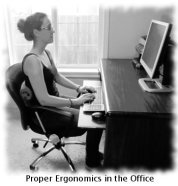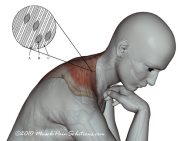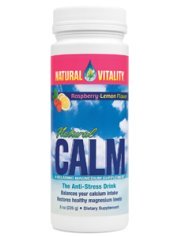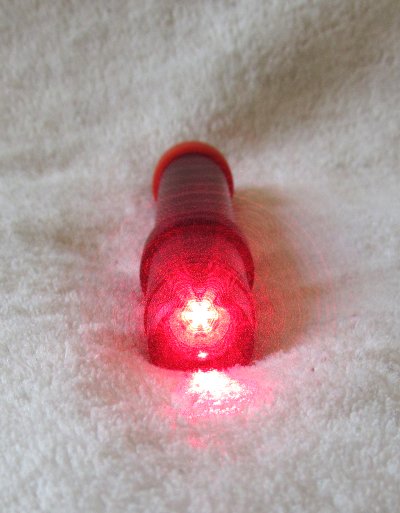Trigger Point Manual:
A must-have for pain sufferers
The Trigger Point Therapy Workbook by Clair Davies, NCTMB and Amber Davis, CMTPT, LMT is a
great trigger point manual telling you all you need to know about
trigger points. They have summarized and expanded upon the most
important information that you need to know from Myofascial Pain and Dysfunction: The Trigger Point Manual by Travell and Simons, which is a 1,500 page, 2-volume work thoroughly covering every aspect of trigger points. Dr. Travell literally "wrote the book" on trigger points, and this manual by Clair and Amber Davies puts the information in a accessible format for even the lay person to understand why they have muscle pain.
Why this trigger point book?
I have reviewed several trigger point books and this is my favorite. I recommend it to patients all the time and keep copies for purchase at the office. Clair Davies did a great job simplifying and covering a fairly complex concept without losing too much information. He made it accessible to a layperson, while keeping enough information that it is useful to a health professional. His daughter, Amber recently updated the book to the third edition adding more illustrations and updating it with the most current information on trigger points.
The Trigger Point Manual by Travell and Simons is much too overwhelming for a layperson and sometimes even for health professionals (though I recommend you have it as a reference if you are a health professional). I actually refer to The Trigger Point Therapy Workbook by Clair Davies several times a month to make sure I am not missing something in a complex case.
Are there illustrations?
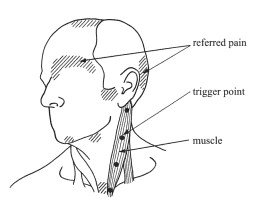
Absolutely! With over 400 illustrations, and almost every muscle illustrated, this is a great resource for a visual learner. Clair and Amber Davies show muscle location, pain referral patterns, and even how to treat some of the more difficult ones. The only shortcoming I find, is sometimes they don't put all the possible pain referral areas on the drawing, but they do talk about them in the text. The illustrations are so clear, most of my patients can apply self-treatment within minutes of locating their pain pattern in the book.
How is this trigger point manual set up?
The first several chapters cover general information about trigger points... important things like what trigger points are and how they form. They also discuss perpetuating factors such as postural and ergonomic stress, and vitamin and mineral deficiency, among other factors.
In the third chapter, they talk about massage guidelines and recommend a variety of massage styles to try. I have 2 styles that I use outlined on this website, one of which is the deep stroking massage page. While this works for some people on some muscles, I have found the lighter hold and release technique to be a better choice for sensitive muscles or individuals. There are several other treatment techniques you can explored here and apply them to the muscles as they describe them.
The Trigger Point Guides
Probably the most useful part of the trigger point manual are the Trigger Point Guides.
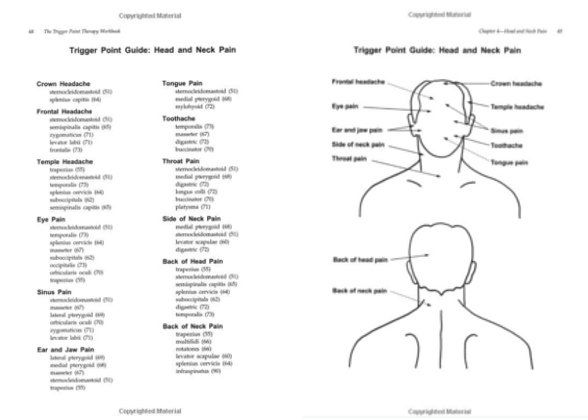
Here is an example of the Trigger Point Guide for head and neck pain. On the right, the body part is illustrated with different parts described. On the left, each body part is listed with the muscles that refer pain to that area listed underneath. The muscles are listed in the order of most likely to least likely to be the pain generator. Next to each muscle is the page number where the muscle is described and illustrated, with the complete pain referral pattern.
Bonus Information
In addition to the very complete information that they provide for finding and eliminating trigger points, they add a whole chapter on clinical trigger point massage, which is very helpful for healthcare practitioners to treat patients in a way that won't compromise their own bodies. This section is also very helpful for people that will be helping family members.
They have another chapter discussing habitual muscle tension, and how you can treat it with Active Tension Release, a wonderful relaxation technique, where you systematically relax muscles throughout you whole body... a very worthwhile technique to master!
Is this a good trigger point manual for professionals?
Absolutely! As I mentioned above, I refer to this book weekly. I use the trigger point guides (beginning of each chapter) frequently to remind me which muscles to check. The Trigger Point Manual by Travell and Simons is way more complete (it should be at 1,500 pages!), but it is much harder to navigate and filled with information I don't use, such as how to perform injections on each muscle. I only use it to look up an ice and stretch pattern or an obscure fact about a muscle. Otherwise, I refer to Davies’ The Trigger Point Therapy Workbook.
For more information on trigger points, go to my Trigger Point Treatment page.
Click here for my
FREE Ebook
and Newsletter!
Find your pain here!

Related Pages
